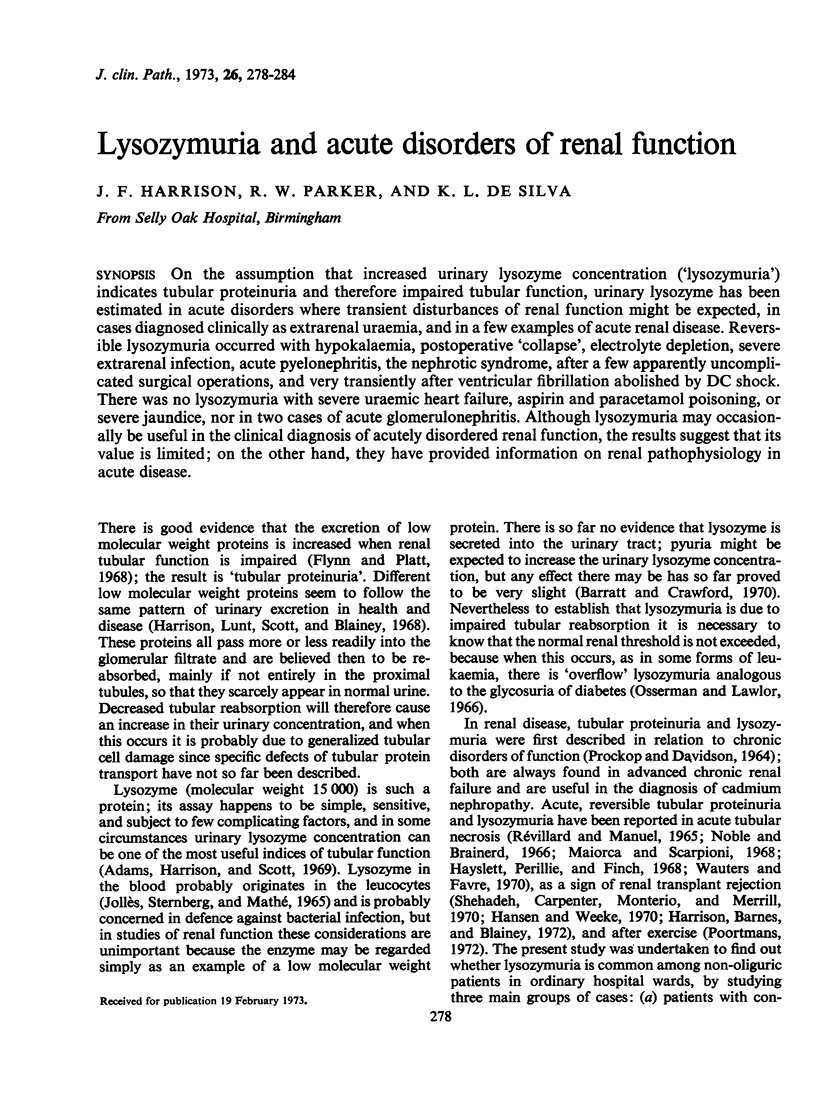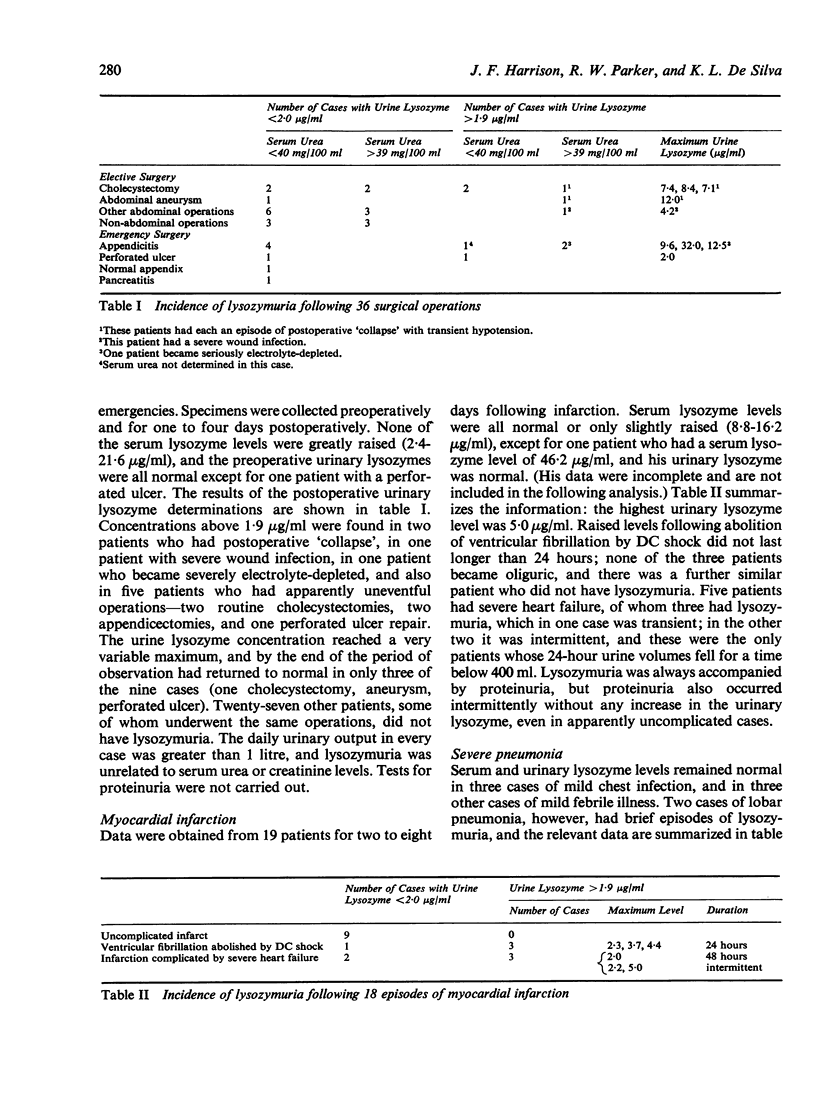Abstract
On the assumption that increased urinary lysozyme concentration (`lysozymuria') indicates tubular proteinuria and therefore impaired tubular function, urinary lysozyme has been estimated in acute disorders where transient disturbances of renal function might be expected, in cases diagnosed clinically as extrarenal uraemia, and in a few examples of acute renal disease. Reversible lysozymuria occurred with hypokalaemia, postoperative `collapse', electrolyte depletion, severe extrarenal infection, acute pyelonephritis, the nephrotic syndrome, after a few apparently uncomplicated surgical operations, and very transiently after ventricular fibrillation abolished by DC shock. There was no lysozymuria with severe uraemic heart failure, aspirin and paracetamol poisoning, or severe jaundice, nor in two cases of acute glomerulonephritis. Although lysozymuria may occasionally be useful in the clinical diagnosis of acutely disordered renal function, the results suggest that its value is limited; on the other hand, they have provided information on renal pathophysiology in acute disease.
Full text
PDF






Selected References
These references are in PubMed. This may not be the complete list of references from this article.
- Adams R. G., Harrison J. F., Scott P. The development of cadmium-induced proteinuria, impaired renal function, and osteomalacia in alkaline battery workers. Q J Med. 1969 Oct;38(152):425–443. [PubMed] [Google Scholar]
- Barratt T. M., Crawford R. Lysozyme excretion as a measure of renal tubular dysfunction in children. Clin Sci. 1970 Sep;39(3):457–465. doi: 10.1042/cs0390457. [DOI] [PubMed] [Google Scholar]
- Flynn F. V., Platt H. S. The origin of the proteins excreted in tubular proteinuria. Clin Chim Acta. 1968 Sep;21(3):377–399. doi: 10.1016/0009-8981(68)90067-3. [DOI] [PubMed] [Google Scholar]
- Hansen N. E., Weeke E. Renal transplantation and muramidase activity. Urinary muramidase as indicator of tubular damage in patients with renal transplants. Acta Med Scand. 1970 Oct;188(4):317–321. [PubMed] [Google Scholar]
- Harrison J. F., Barnes A. D., Blainey J. D. Lysozymuria and renal transplantation. Transplantation. 1972 Apr;13(4):372–377. doi: 10.1097/00007890-197204000-00004. [DOI] [PubMed] [Google Scholar]
- Harrison J. F., Barnes A. D. The urinary excretion of lysozyme in dogs. Clin Sci. 1970 Apr;38(4):533–547. doi: 10.1042/cs0380533. [DOI] [PubMed] [Google Scholar]
- Harrison J. F., Lunt G. S., Scott P., Blainey J. D. Urinary lysozyme, ribonuclease, and low-molecular-weight protein in renal disease. Lancet. 1968 Feb 24;1(7539):371–375. doi: 10.1016/s0140-6736(68)91350-0. [DOI] [PubMed] [Google Scholar]
- Harrison J. F., Swingler M. The effect of serum macromolecules on the lysis of Micrococcus lysodeikticus cells by lysozyme. Clin Chim Acta. 1971 Jan;31(1):149–154. doi: 10.1016/0009-8981(71)90372-x. [DOI] [PubMed] [Google Scholar]
- Hayslett J. P., Perillie P. E., Finch S. C. Urinary muramidase and renal disease. Correlation with renal histology and implication for the mechanism of enzymuria. N Engl J Med. 1968 Sep 5;279(10):506–512. doi: 10.1056/NEJM196809052791002. [DOI] [PubMed] [Google Scholar]
- Jollès J., Jollès P. Human tear and human milk lysozymes. Biochemistry. 1967 Feb;6(2):411–417. doi: 10.1021/bi00854a007. [DOI] [PubMed] [Google Scholar]
- Noble R. E., Brainerd H. D. Urine and serum lysozyme alterations in a case of acute renal failure. J Urol. 1966 Dec;96(6):852–853. doi: 10.1016/S0022-5347(17)63364-0. [DOI] [PubMed] [Google Scholar]
- Osserman E. F., Lawlor D. P. Serum and urinary lysozyme (muramidase) in monocytic and monomyelocytic leukemia. J Exp Med. 1966 Nov 1;124(5):921–952. doi: 10.1084/jem.124.5.921. [DOI] [PMC free article] [PubMed] [Google Scholar]
- PROCKOP D. J., DAVIDSON W. D. A STUDY OF URINARY AND SERUM LYSOZYME IN PATIENTS WITH RENAL DISEASE. N Engl J Med. 1964 Feb 6;270:269–274. doi: 10.1056/NEJM196402062700602. [DOI] [PubMed] [Google Scholar]
- Peterson P. A., Evrin P. E., Berggård I. Differentiation of glomerular, tubular, and normal proteinuria: determinations of urinary excretion of beta-2-macroglobulin, albumin, and total protein. J Clin Invest. 1969 Jul;48(7):1189–1198. doi: 10.1172/JCI106083. [DOI] [PMC free article] [PubMed] [Google Scholar]
- Poortmans J. R. Effect of exercise on the renal clearance of amylase and lysozyme in humans. Clin Sci. 1972 Jul;43(1):115–120. doi: 10.1042/cs0430115. [DOI] [PubMed] [Google Scholar]
- Pruzanski W., Platts M. E. Serum and urinary proteins, lysozyme (muramidase), and renal dysfunction in mono- and myelomonocytic leukemia. J Clin Invest. 1970 Sep;49(9):1694–1708. doi: 10.1172/JCI106387. [DOI] [PMC free article] [PubMed] [Google Scholar]
- SMOLELIS A. N., HARTSELL S. E. The determination of lysozyme. J Bacteriol. 1949 Dec;58(6):731–736. doi: 10.1128/jb.58.6.731-736.1949. [DOI] [PMC free article] [PubMed] [Google Scholar]
- Shehadeh I. H., Carpenter C. B., Monterio C. H., Merrill J. P. Renal allograft rejection. An analysis of lysozymuria, serum complement, lymphocyturia, and heterophil antibodies. Arch Intern Med. 1970 May;125(5):850–857. doi: 10.1001/archinte.125.5.850. [DOI] [PubMed] [Google Scholar]
- Wauters J. P., Favre H. L'intérêt de la mesure du lysozyme urinaire dans le diagnostic des néphropathies. Schweiz Med Wochenschr. 1970 Nov 7;100(45):1903–1907. [PubMed] [Google Scholar]
- Wiernik P. H., Serpick A. A. Clinical significance of serum and urinary muramidase activity in leukemia and other hematologic malignancies. Am J Med. 1969 Mar;46(3):330–343. doi: 10.1016/0002-9343(69)90036-9. [DOI] [PubMed] [Google Scholar]


